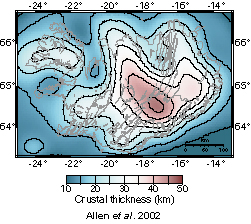| Home |
| Research |
| Downloads |
| Publications |
| Teaching |
| People |
| Press |
| Allen CV |
| Seismo Lab |
| Earth & Planetary |
| UC Berkeley |
|
The ICECRTb model: | |
|
The PASSCAL-HOTSPOT project started with a deployment of 35 broadband seismometers across Iceland from the summer of 1996 till the summer of 1998. The continuously recorded high quality data has been used to determine the 3D velocity structure of the crust and mantle beneath Iceland. You can download pre-prints detailing the crustal and mantle studies. Here we offer a brief description of the crustal model and figures showing the velocity structure beneath Iceland. See the papers for more details on methods and interpretation of these results. |

|
| Links to figures and the model |
|
2D slices through the models
|
|
Download the models. You can also download the full model data files along with code to extract velocities. |
|
Abstract Through combination of surface wave and body wave constraints we derive a 3-D crustal S-velocity model and Moho map for Iceland. It reveals a vast plumbing system feeding mantle plume melt into upper crustal magma chambers where crustal formation takes place. The method is based on the Partitioned Waveform Inversion to which we add additional observations. Love waves from six local events recorded on the PASSCAL-HOTSPOT and SIL networks are fitted, Sn travel times from the same events measured, previous observations of crustal thickness are added, and all three sets of constraints simultaneously inverted for our 3-D model. In the upper crust (0-15 km) an elongated low-velocity region extends along the length of the Northern, Eastern and Western Neovolcanic Zones. The lowest velocities (-7%) are found at 5-10 km below the two most active volcanic complexes: Hekla and Bardarbunga-Grimsvotn. In the lower crust (> 15 km) the low-velocity region can be represented as a vertical cylinder beneath central Iceland. Low velocities are not found along the length of the neovolcanic zones. The low-velocity structure is interpreted as the thermal halo of pipe work which connects the region of melt generation in the uppermost mantle beneath central Iceland to active volcanoes along the neovolcanic zones. Crustal thickness in Iceland varies from 15-20 km beneath the Reykjanes Peninsula, Krafla and the extinct Snaefellsnes rift zone, to 46 km beneath central Iceland. The average crustal thickness is 29 km. The variations in thickness can be explained in terms of the temporal variation in plume productivity over the last ~20 Ma, the Snaefellsnes rift zone being active during a minimum in plume productivity. Variations in crustal thickness do not depart significantly from an isostatically predicted crustal thickness. The best fit linear isostatic relation implies an average density jump of 4% across the Moho. Rare Earth Element inversions of basalt compositions on Iceland suggest a melt thickness (i.e., crustal thickness) of 15-20 km, given passive upwelling. The observed crustal thickness of up to 46 km implies active fluxing of source material through the melt zone by the mantle plume at up to three times the passive rate. For more see the full JGR paper. |
© Richard M Allen
